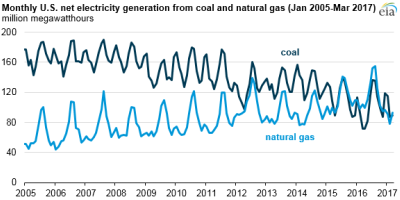EIA: Competition between coal, natgas affects power markets
In 2016, natural gas provided 34% of total electricity generation, surpassing coal to become the leading generation source. Natural gas first exceeded coal as the most common electricity fuel on a monthly basis in April 2015 and on an annual basis in 2016. The increase in natural gas generation since 2005 is primarily a result of the continued cost competitiveness of natural gas relative to coal.
 |
| Courtesy of EIA. |
Natural gas-fired capacity is widely distributed across the United States. Every state except Vermont has at least one natural gas plant. In the past 15 yr, nearly 228 GW of capacity fueled by natural gas was added, far exceeding retirements of 54 GW. Over that same period, 20 GW of coal-fired capacity was added, while more than 53 GW was retired.
Regionally, coal remains the dominant fuel for electricity generation in the Midwest, although its share has decreased over the past several years. In the Northeast, electricity generation with natural gas has exceeded coal-fired generation since February 2011. In the South, monthly natural gas generation surpassed that of coal in every month since January 2015. In the West, electricity generated by coal and natural gas has remained in close competition over the past decade; however, natural gas exceeded coal in the power sector for 11 months during 2016.
The competition of coal and natural gas for electricity generation plays an important role in setting wholesale electricity prices. The changing use of natural gas and coal in electricity generation also has implications for the production, transport, and storage of coal and natural gas.

- ExxonMobil halts 1-Bft3d blue hydrogen project in Texas
- Aramco and Yokogawa commission multiple autonomous control AI agents at Fadhili gas plant
- Ukraine will resume gas imports via Transbalkan route in November
- Mitsubishi to inject $260 MM into Brunei LNG project
- Freeport LNG (U.S.) on track to take in more natgas on Thursday after unit outage



Comments